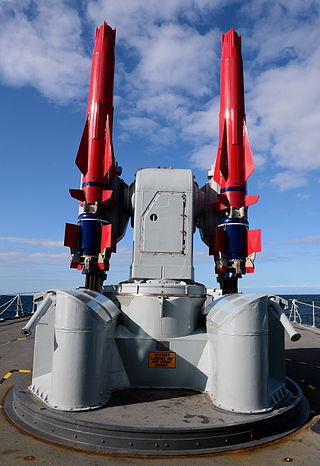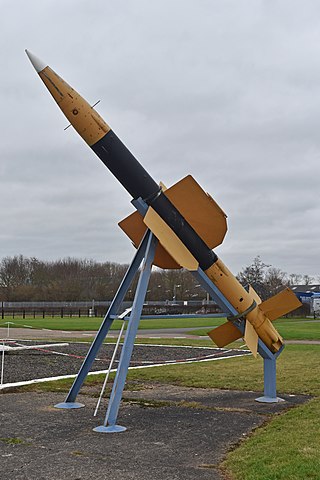
The County class was a class of British guided missile destroyers, the first such warships built by the Royal Navy. Designed specifically around the Seaslug anti-aircraft missile system, the primary role of these ships was area air defence around the aircraft carrier task force in the nuclear-war environment.

HMS Devonshire was the first of the County-class destroyers and the first Batch 1 ship of the Royal Navy. The ship was built by Cammell Laird in Birkenhead near Liverpool. With a displacement of 5,440 tonnes, Devonshire was named after the English county of Devon. She was launched on 10 June 1960 and delivered to the navy two years later.

HMS Fife was the first unit of the Batch 2 County-class destroyers of the Royal Navy. She was subsequently sold to Chile and scrapped in 2005.

HMS Glamorgan was a County-class destroyer of the Royal Navy with a displacement of 5,440 tonnes. The ship was built by Vickers-Armstrongs in Newcastle Upon Tyne and named after the Welsh county of Glamorgan.

HMS Hampshire was a County-class destroyer of the Royal Navy. Laid down, in March 1959 a couple of weeks behind the class leader Devonshire, she was classified as a guided missile destroyer, as the Sea Lords regarded the concept of the cruiser and big gun ship as discredited by the perceived failure of the Tiger class and the obsolescence of the heavy gun. The description of guided missile destroyer seemed more likely to win approval from the Treasury and Government for an adequate number of warships the size of small cruisers, which could play many traditional cruiser flagship and command functions, but had no armour around its gun and missile magazine.

RFA Resurgent (A280) was an armament support ship of the Royal Fleet Auxiliary. Built by Scotts of Greenock as Changchow, a cargo/passenger liner for the China Navigation Co. Made redundant by the Communist victory in 1949, Changchow and her sistership Chungking were chartered to the French « Messageries Maritimes », for the Marseilles-Sydney line, via Panama. Purchased by the Admiralty and chartered out to British India until 1957. In 1956-1957, under the name Resurgent, she was again chartered to the « Messageries Maritimes », making trips to New Caledonia and Australia. After that, she was converted to an armament store issuing ship and entered RFA service.

Future planning of the Royal Navy's capabilities is set through periodic Defence Reviews carried out by the British Government. The Royal Navy's role in the 2020s, and beyond, is outlined in the 2021 defence white paper, which was published on 22 March 2021. The white paper is one component of the Integrated Review of Security, Defence, Development and Foreign Policy, titled as Global Britain in a Competitive Age which was published on 16 March 2021.

Sea Dart, or GWS.30 was a Royal Navy surface-to-air missile system designed in the 1960s and entering service in 1973. It was fitted to the Type 42 destroyers, Type 82 destroyer and Invincible-class aircraft carriers of the Royal Navy. Originally developed by Hawker Siddeley, the missile was built by British Aerospace after 1977. It was withdrawn from service in 2012.

Seaslug was a first-generation surface-to-air missile designed by Armstrong Whitworth for use by the Royal Navy. Tracing its history as far back as 1943's LOPGAP design, it came into operational service in 1961 and was still in use at the time of the Falklands War in 1982.

The General Dynamics RIM-24 Tartar was a medium-range naval surface-to-air missile (SAM), among the earliest SAMs to equip United States Navy ships. The Tartar was the third of the so-called "3 Ts", the three primary SAMs the Navy fielded in the 1960s and 1970s, the others being the RIM-2 Terrier and RIM-8 Talos.

His Majesty's Naval Service is the United Kingdom's naval warfare and maritime service. It consists of the Royal Navy, Royal Marines, Royal Fleet Auxiliary, Royal Naval Reserve, Royal Marines Reserve and Naval Careers Service. The term Naval Service should be distinguished from the "UK Naval Services", which consist of the Naval Service and the Merchant Navy. The Naval Service as a whole falls under the command of the Navy Board, which is headed by the First Sea Lord. This position is currently held by Admiral Sir Ben Key. The Defence Council delegates administration of the Naval Service to the Admiralty Board, chaired by the Secretary of State for Defence.

Messageries Maritimes was a French merchant shipping company. It was originally created in 1851 as Messageries nationales, later called Messageries impériales, and from 1871, Compagnie des messageries maritimes, casually known as "MesMar" or by its initials "MM". Its rectangular house flag, with the letters MM on a white background and red corners, was famous in shipping circles, especially on the Europe-Asia trade lanes. In 1977 it merged with Compagnie générale transatlantique to form Compagnie générale maritime. In 1996 CGM was privatized and sold to Compagnie Maritime d'Affrètement (CMA) to form CMA CGM.

USS Rochambeau (AP-63) was a transport ship that saw service in the United States Navy during World War II. She was the only U.S. Naval vessel to be named for the French nobleman, Jean-Baptiste Donatien de Vimeur, comte de Rochambeau (1725–1807), who commanded the French troops in Washington's army during the American Revolutionary War.

Georges Philippar was an ocean liner of the French Messageries Maritimes line that was built in 1930. On her maiden voyage in 1932 she caught fire and sank in the Gulf of Aden with the loss of 54 lives.

SS Patria was an 11,885 GRT French ocean liner built in 1913 for Compagnie française de Navigation à vapeur Cyprien Fabre & Cie, for whom she was first a transatlantic liner and then an emigrant ship. From 1932 Fabre Line leased her to Services Contractuels des Messageries Maritimes, who ran her between the south of France and the Levant. After the fall of France in June 1940 the British authorities in Mandatory Palestine seized her in the Port of Haifa and placed her under the management of the British-India Steam Navigation Company. In November 1940, the Zionist movement Haganah planted a bomb aboard which sank her with the loss of between 260 and 300 lives. Patria remained a wreck in Haifa port until she was scrapped in 1952.
SS Athos was a French cargo-passenger ship of the Messageries Maritimes, launched in 1914, that was sunk in the Mediterranean by the German submarine SM U-65 during World War I.

The Clausen Rolling Platform was a missile launching platform, built at the coastal missile test range of RAE Aberporth, West Wales, in the 1950s. It used a floating platform in a pool of water to simulate the rolling of a ship at sea, without the drawbacks and costs of going to sea. The Platform was first used for development trials of the Seaslug missile.
HMS Girdle Ness was a Beachy Head-class repair ship constructed for the Royal Navy that entered service in 1945. Originally named Penlee Point, the vessel was designed as a maintenance ship for landing craft in the Pacific Theatre of World War II but used as an accommodation ship at Rosyth Dockyard. Renamed Girdle Ness, the ship was taken out of service in 1953 and converted for use in support of missile trials in the development of the Seaslug missile in the early 1960s. After trials of the missile were completed, Girdle Ness was placed in reserve before becoming an accommodation ship as part of the shore establishment HMS Cochrane at Rosyth. The vessel was stricken in 1970.

Compagnie de Navigation Sud-Atlantique was a French shipping company prominent in the South American routes.
SS Viet-Nam was an Ocean Liner built in Dunkirk, France for Messageries Maritimes in 1953. Viet-Nam was built along with two sister ships, the SS Cambodge and SS Laos. She mainly provided passenger service between France, the Middle East, Southeast Asia, and Japan.















